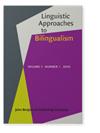日语浮点数量词的二语确定性习得
IF 1.8
2区 文学
0 LANGUAGE & LINGUISTICS
引用次数: 1
摘要
本研究调查了母语为英语和韩语的人在第二语言习得日语浮动数量词(NQs)中的确定性约束。这种约束的产生是由于浮动NQ与其相关名词之间的特定结构关系,导致强制性不确定解释。在这种结构中,明确性的间接或隐蔽编码允许对基于Cho和Slabakova(2014)提出的难度曲线的预测进行调查,即如果第一语言(L1)公开表达相关特征,可能会促进第二语言对隐蔽属性的习得。英语就是这样一种语言,用明显的词法来表达确定性,而韩语则像日语一样,有强制性的、隐蔽的、不确定的浮动nq。使用可接受性判断任务来测量日语浮动nq对确定性的敏感性。虽然说l1 -韩语和l1 -英语的日本人在群体水平上都表现出对约束的敏感性,但后续分析表明,韩语组的知识更一致。我们认为习得任务的复杂性(英语学习者比韩语学习者更复杂)比显性和隐性的L1相关特征编码在习得过程中发挥了更大的作用。本文章由计算机程序翻译,如有差异,请以英文原文为准。
L2 acquisition of definiteness in Japanese floating numeral quantifiers
This study investigates the second language (L2) acquisition of a constraint on definiteness in Japanese floating numeral quantifiers (NQs) by native English and Korean speakers. The constraint arises because of the specific structural relation between a floating NQ and its associated noun, resulting in an obligatorily indefinite interpretation. The indirect – or, covert – encoding of definiteness in this structure allows investigation of predictions based on the cline of difficulty proposed by Cho and Slabakova (2014), whereby L2 acquisition of a covert property may be facilitated if the first language (L1) expresses the relevant feature overtly. English is such a language, having overt morphology to express definiteness, whereas Korean has floating NQs that are obligatorily, and covertly, indefinite, as in Japanese. Sensitivity to definiteness in Japanese floating NQs was measured using an acceptability judgement task. Although both L1-Korean and L1-English speakers of Japanese showed sensitivity to the constraint at group level, follow-up analyses suggested that the Korean group had more consistent knowledge. We argue that the complexity of the acquisition task – which was greater for the English-speakers than the Korean-speakers – played a bigger role in attainment than overt versus covert encoding of the relevant feature in the L1.
求助全文
通过发布文献求助,成功后即可免费获取论文全文。
去求助
来源期刊

Linguistic Approaches To Bilingualism
Social Sciences-Linguistics and Language
CiteScore
3.20
自引率
9.10%
发文量
24
期刊介绍:
LAB provides an outlet for cutting-edge, contemporary studies on bilingualism. LAB assumes a broad definition of bilingualism, including: adult L2 acquisition, simultaneous child bilingualism, child L2 acquisition, adult heritage speaker competence, L1 attrition in L2/Ln environments, and adult L3/Ln acquisition. LAB solicits high quality articles of original research assuming any cognitive science approach to understanding the mental representation of bilingual language competence and performance, including cognitive linguistics, emergentism/connectionism, generative theories, psycholinguistic and processing accounts, and covering typical and atypical populations.
 求助内容:
求助内容: 应助结果提醒方式:
应助结果提醒方式:


